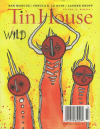Tin House – Fall 2013
This “Wild” issue of Tin House is special in that it contains both cover art and a feature from Matt Kish’s illustrated version of Conrad’s classic Heart of Darkness. As usual, Tin House features great work from poets, fiction writers, essayists, and reviewers. It has everything from essays on Vegas brothels or snakes to a “Readable Feast” that ends with a recipe for barnacles. Fair warning though, with a cover this visually stunning, you may never be able to actually open it.
This “Wild” issue of Tin House is special in that it contains both cover art and a feature from Matt Kish’s illustrated version of Conrad’s classic Heart of Darkness. As usual, Tin House features great work from poets, fiction writers, essayists, and reviewers. It has everything from essays on Vegas brothels or snakes to a “Readable Feast” that ends with a recipe for barnacles. Fair warning though, with a cover this visually stunning, you may never be able to actually open it.
Lauren Groff’s fiction piece “Salvador” captures the “wild” theme this issue of Tin House has chosen to embrace. “Salvador” is a story told in the third person that follows a middle-aged woman named Helena on a vacation to Salvador where she is forced to confront herself and her life and embrace both. The story progresses in a downward spiraling fashion picking up momentum with each sentence. Helena spends most of her time taking care of her ailing mother, but at least once a year she is able to go on an extravagant vacation with money she is given from her two sisters who can’t help out most of the year because of their jobs and families. Helena spends her vacation clinging to her “slowly departing” mother and having her way with men. This particular vacation, however, teaches Helena something no other one has: she is a caretaker, regardless of how much she wishes to exploit her beauty, bed men, and live carefree.
Tin House sticks close to home in the issue and publishes an essay “The Last Days of the Baldock” by Inara Verzemnieks. Verzemnieks takes an in-depth look at residents of a transient community that has been formed on a highway rest stop near Portland, Oregon called the Baldock. Verzemnieks recants the history of the Baldock as it was told to her and as she witnessed its final days; it is a story of basic humanity. Verzemnieks seeks to bring understanding to readers about people who become part of communities such as the Baldock because they are not the stereotypical transient community dwellers most people picture. Many work hard, such as a man named Jack who, despite working full time at a factory job and budgeting his money every month, is forced to sleep in his car at the Baldock every day. Jack tells Verzemnieks they want to pay taxes again, “They want to feel normal.” Not only did the residents long to feel normal, but they longed to have a place to call home where they are not forced to face the fact that they are truly alone in the world.
Kimberly Grey’s “System of Becoming Quite” is a poem about “quietness,” containing multiple levels that are all well-crafted. This poem expresses how love can come to seem perfect. To express the inability to truly become something, Grey uses the suffix “-ish” multiple times to convey having the likeness of something: “. . . once we were happyish people, we were / unrecognizable in our yellowish folds. It was / a pretty way to start . . .” The “happyish” explains a certain romanticism that often happens when people look back on horrible relationships and say that at the beginning they were good. Grey continues: “almost beaming. If it is brutal, then brutalish / is a way to live. Lovers never sufficiently love / anything. It’s a wildish thing . . .”
Even in the moments when Grey is not using “-ish” to convey “quiteness” the orchestration of words still convey it—“almost beaming” and “lovers never sufficiently love” for example—all of these things work together to display the trivial attempts we all make to do something perfectly or embody something perfectly. This is one of two “System” poems Grey has in this issue of Tin House and is part of a bigger project Grey has been working on. All are well worth reading.
In the Matt Kish feature, Kish discusses his Heart of Darkness and the “terrifying feeling of claustrophobia” to the story, and the sense of “only moving downward”—which he acknowledges is something each illustration had to follow. Kish discusses the challenge of not just illustrating Heart of Darkness but even more importantly, conveying that what happens in the novel is “horrifyingly universal.” Kish explains that to accomplish this, he had to pull the illustrations away from reality so the viewer could not place them in a specific time or place but could still relate them to the story itself. The feature includes ten pages from Kish’s illustrated novel, and each one is captivating and allows you to get a sense of the “downward” progression Kish describes.
Whether you are a writer, an illustrator, or a casual reader, let this issue of Tin House make you wildish; pick up a copy today and see where it can take you.
[www.tinhouse.com]





